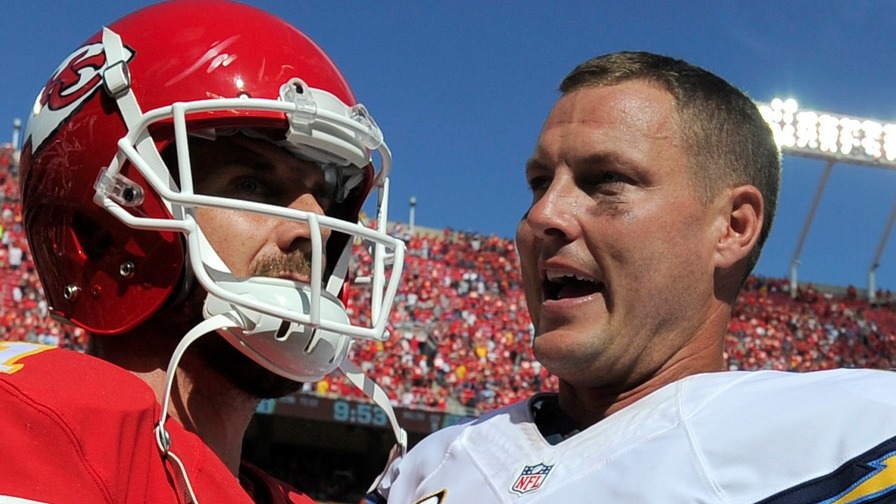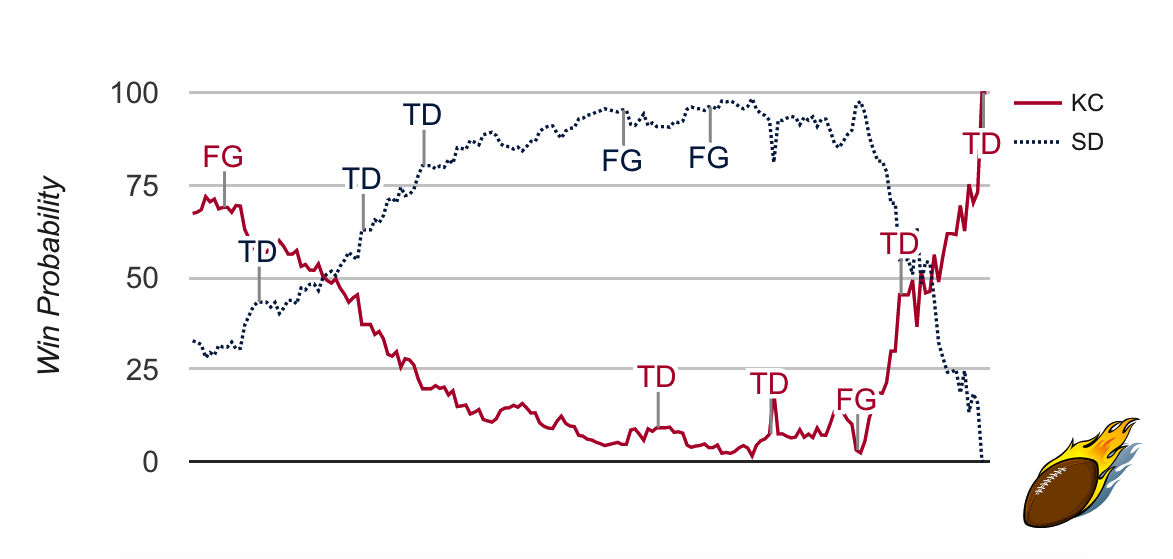What Kansas City's Comeback Over San Diego Means for Both Sides

Midway through the early games in Week 1 of the 2016 NFL season, the most shocking development was the dominance of the San Diego Chargers against the Kansas City Chiefs.
By the time the early games were over, the most shocking development was that the Chiefs had won.
The end result probably wasn’t all that surprising to those who paid no attention to what happened during the game and just saw the final score. In that case, someone just seeing the score flash across the bottom of the screen might have been impressed the Chargers even took the Chiefs into overtime.
But Kansas City was supposed to win the game. They were favored by 6.5 points, and they had a 67.3 percent chance of winning when the game kicked off, per numberFire Live.
But for the first 59 minutes or so, the Chargers were the better team. San Diego leapt out to a 27-10 lead and peaked at a 98.5 percent win probability with 10:27 remaining in the fourth quarter, though shortly after is where the comeback became possible for Kansas City.
Four plays later -- one of which was a 4th-and-2 conversion near midfield -- the Chiefs scored a touchdown to bring the score to 27-17, but their win probability was still just 7.47 percent.
The Chiefs kept chipping away at the lead. Kansas City kicked a field goal to bring the game within a touchdown with just over three minutes remaining, but with so little time left on the clock, their win probability was just 3.1 percent.
Kansas City proceeded to force a three-and-out by San Diego thanks to two bad forced screens to Travis Benjamin on second and third down. The Chiefs were also gifted a 17-yard punt from rookie Drew Kaser, which started Kansas City’s drive at San Diego’s 42-yard line.
This was really the first point when watching that a Kansas City comeback was possible. Four plays later, the Chiefs were in the end zone again with a five-yard touchdown run by Spencer Ware, but even in a tied game, the Chiefs didn’t have the advantage mathematically.
With 1:03 left, when the Chiefs kicked to the Chargers after the score, Kansas City’s win probability was only 45.2 percent.
It wasn’t until a sack of Philip Rivers from Dee Ford with 53 seconds remaining did the Chiefs achieve their first favorable odds of winning the game since there was 3:50 remaining in the first quarter.
The probability would never shift back into San Diego's favor.
Kansas City forced a punt on San Diego’s final drive in regulation and received the kick in overtime. 10 plays and 70 yards later, Alex Smith rushed two yards into the end zone, and the Chiefs came away with the most improbable of expected victories.

Who, What, Ware
With star running back Jamaal Charles out due to an injury, Spencer Ware stepped in as the starter, and there was no Chief more important to Sunday’s result. Ware and fellow back Charcandrick West both saw the same amount of snaps on the field Sunday (34), but Ware was featured significantly more in the game plan.
Ware only carried the ball 11 times during the game but was the most efficient runner by our Net Expected Points (NEP) metric -- NEP measures the value of each play on the field based on how an average team would be expected to perform, according to historical data.
Of the 30 players who had at least 10 rushing attempts in Week 1, Ware’s 0.37 Rushing NEP per attempt was the highest. Only David Johnson of Arizona also reached 0.30. A lot can happen in just one game with a limited sample of carries, but that type of efficiency is remarkable.
Johnson led all backs last season with at least 100 carries with a Rushing NEP per carry of 0.15, but Ware maintained a rate of 0.20 over 72 carries, second-best among backs with 50 or more carries.
Kansas City’s game script did not allow for many rushing attempts, but that didn’t stop Ware from being involved. Last season, Ware was not heavily involved in the team’s passing game. He had just six targets, all of which went for receptions, but just five receiving yards.
On Sunday, Ware blew all of that out of the water with 7 catches on 8 targets for 129 yards. He was the third most efficient receiver of Week 1 by Reception NEP per target among players with at least eight targets and the most efficient of those players who were not thrown passes by Drew Brees -- Willie Snead and Brandin Cooks were first and second.
Charles might be healthy enough to play in Week 2, and while he’s still one of the best all-around backs in the league, it’s going to be tough to keep Ware off the field -- especially when he’s making plays downfield like this from the first play in overtime. (Video courtesy NFL Game Pass.)
Requiem for a Dream
If it wasn’t bad enough for the Chargers to take a loss in a game they dominated, they lost something much worse in the third quarter -- receiver Keenan Allen. Allen fell to the ground with a non-contact injury early in the second half, and like most non-contact injuries that involve knees, the fear is a torn ACL. That would end Allen’s season prematurely for the second straight season after a lacerated kidney ended his 2015 campaign.
Allen was finally healthy heading into the season, and big things were expected of the third-year receiver, who just received a contract extension in the offseason. We were among them, projecting Allen to have the third-most receptions in the league this season. In the time he was on the field, Allen looked exactly as expected, dominating last year’s Defensive Rookie of the Year Marcus Peters. Allen played just 27 snaps and was targeted 7 times with 6 receptions and 63 yards. When Philip Rivers needed to complete a pass, Allen was his target.
The Chargers' offense didn’t crumble after Allen left the game, but there were spots when his presence was missed. As noted earlier, on San Diego’s second-to-last drive of regulation, the Chargers ran two forced screens to Travis Benjamin, which combined for -2 yards on second and third down. It’s not hard to imagine quick slants to Allen being the call there if he was on the field.
San Diego will now have to regroup from injuries again, something that helped derail the previous two seasons. Benjamin, who led the Chargers with eight targets, will likely take over as Rivers’ go-to receiver out wide. The main go-to will remain Danny Woodhead, who saw 7 targets but gained just 31 yards.
Woodhead also looks to remain the main back when things are going well. He out-carried Melvin Gordon 16 to 14 and out-rushed him 89 to 57, though Gordon did get his first two rushing touchdowns of his career. Second-year receiver Tyrell Williams might also see increased playing time. He had just 2 catches on 5 targets and 44 snaps -- most of which came later in the game -- but those 2 catches resulted in a team-leading 71 yards and an impressive 0.87 Reception NEP per target.
















